by Patrick Roefflaer
- Released Augustus 12, 1981
- Illustration Pearl Beach
- Photographer Howard Alk
- Art-director Pearl Beach
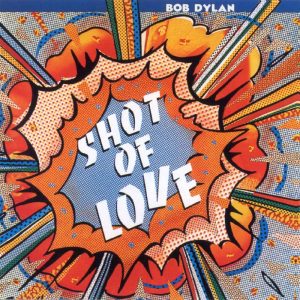 “For those who care about where Bob Dylan is, they should listen to ‘Shot of Love’”, declared the singer himself in July 1983, to Martin Keller of Minneapolis City Pages. “It’s my most perfect song. It defines where I am spiritual, musical, romantic and whatever. It shows where my preferences lie. It’s all there in that one song.”
“For those who care about where Bob Dylan is, they should listen to ‘Shot of Love’”, declared the singer himself in July 1983, to Martin Keller of Minneapolis City Pages. “It’s my most perfect song. It defines where I am spiritual, musical, romantic and whatever. It shows where my preferences lie. It’s all there in that one song.”
This sounds very much like promo talk for his new album, except by that time the record has been in stores for close to two years.
This enthusiasm might explain why Dylan not only used ‘Shot of Love’ as the title track for the album, but also wanted to see it illustrated on the cover. Its live-in-the-studio sound defines the sound of his 21st studio album. The sound splashes out of the boxes. That’s the feeling he wanted to show.
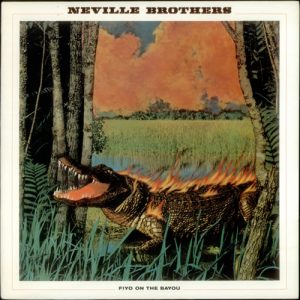 Probably it was the second album of The Neville Brothers that put the illustrator Pearl Beach on Dylan’s radar.
Probably it was the second album of The Neville Brothers that put the illustrator Pearl Beach on Dylan’s radar.
On the sleeve of Fiyo on the Bayou, released in April 1981, there’s an intriguing painting of a crocodile on fire. That art work was made by Lou and Pearl Beach.
Dylan’s management contacts the artists, with precise instructions of what he wants.
Two illustrations are commissioned: an explosion for the front and “the rear of a Cadillac with a cloud of exhaust fumes”, for the back.
Lou and Pearl Beach
Andrzej Lubicz-Ledóchowski was born in a Polish family in 1947 in Göttingen, Germany. When the boy was six years old, the Polish parents displaced by the Second World War, emigrated to Rochester, NY.
In 1968, Andrzej travelled to California, where he began an artistic career by making assemblages and collages, under the name Lou Beach (derived from the phonetic pronunciation of his family name Lubicz).
In the mid-seventies, he made his first album covers.
In 1978, he started working with Katherine Walter, six years his junior, who had studied art and Native American anthropology in Santa Monica. As Lou and Pearl Beach, they designed covers for Weather Report, Yellow Magic Orchestra, and The Neville Brothers.
However, around the time Dylan’s management contacted them, Lou and Pearl split up and the collaboration between the couple ended.
When I wrote to both Lou and Pearl Beach, Lou only said that he couldn’t help me with this particular album and that I should turn to his ex.
After a failed lawsuit against Mattel over the use of the name Pearl Beach for a Barbie doll, followed by bankruptcy, she withdrew to a remote farm in Albuquerque, New Mexico. Pearl Beach declined to comment.
The only interview with her about the subject, I have been able to find is in Daily News from New York, New York. In the interview, published in August 1981, Katherine shows herself somewhat dissatisfied with the back cover: “He wanted the rear of a Cadillac with a cloud of exhaust fumes. So I made a collage of photos and painted them over: a car in the air, where the exhaust fumes went up in the clouds. On the cover is a Bible quote, from Matthew 11:25. So I put M1125 on the license plate. But he changed that to 666.”
666 is known as the number of the beast, as in the Book of Revelation of the new Testament it is stated that the number indicates the Antichrist.
For the first Brazilian pressing of Shot of Love, the illustration of the Cadillac was used for the back cover. Here however, the license plate of the Cadillac has neither M1125 nor 666: the license plate is black.
For the explosion on the front, inspiration is found by Roy Lichtenstein. The American pop art artist made paintings “as artificial as possible”. By using unicolor dots, such as the grid points that were used in comic books during the sixties and seventies, his paintings look like greatly enlarged comic drawings.
His most famous work is titled, Whaam!, dated 1963 On the left side of the large two-part painting is an American fighter plane firing a missile. The result of that action is displayed on the right panel: the approaching, hostile plane, bursts apart in a huge explosion. Comic strip-wise, the explosion is emphasized with a sound imitation: Whaam!
For the official releases (outside Brazil) the Cadillac has been replaced by a photo of Dylan contemplating a rose.
The black-and-white photo was made by Howard Alk.
Alk was a longtime friend and collaborator of Bob Dylan, producing his films from the mid-Sixties until his death in January 1982.
On the site Searching for a gem, one can find two test pressing for the album sleeve.
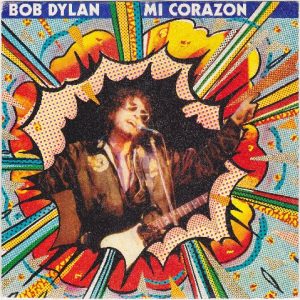 On the first, with the Cadillac illustration on the back, the letters of the title in the explosion are in white.
On the first, with the Cadillac illustration on the back, the letters of the title in the explosion are in white.
The second slick, with the rose photo, has a black text version of the front sleeve.
The final version again opted for white letters…
… except in the UK, where (probably by mistake) the black lettering is used for the original LP sleeve.
——————————
Here are the articles so far in this series. All are by Patrick Roefflaer.
- Another side of Bob Dylan
- Biograph – see Empire Burlesque
- Blonde On Blonde: The Artwork
- Blood on the Tracks
- Bob Dylan
- Bob Dylan’s Greatest Hits
- Bringing it All Back Home
- Desire
- Down in the Groove
- Dylan
- Empire Burlesque and Biograph artwork
- Good as I’ve been to you
- Greatest Hits Volume II
- Highway 61 Revisited
- Infidels: what’s in a name?
- John Wesley Harding: the art work
- Knocked Out Loaded
- Love and Theft
- Nashville Skyline
- New Morning
- Oh Mercy
- Pat Garrett and Billy the Kid
- Self-Portrait
- Slow Train Coming
- Street Legal and the secret cover location
- The Basement Tapes
- The Freewheelin’ Bob Dylan – the untold story of the artwork of the album
- The Times they are a changin’ album artwork
- Time out of Mind
- Travelling Wilburys Vol 1 (guest visitor, Michael Palin)
- Triplicate
- World Gone Wrong

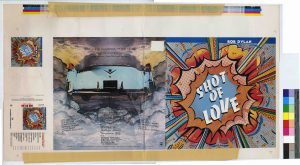
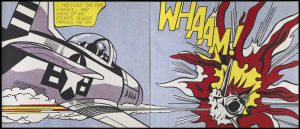
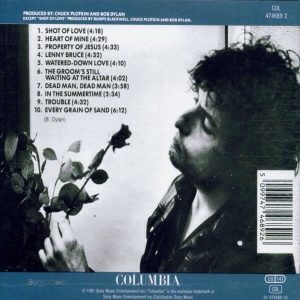
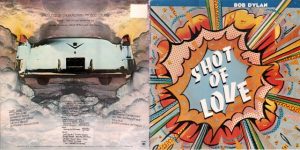
Interesting!!
The question is why the nod to Lichtenstein? And why in 1981? The answer is simple: An important Lichtenstein retrospective was shown at the Saint Louis Art Museum in the spring of 1981, which Dylan must have been aware of (it was a big thing at the time) and which probably influenced the cover design of “Shot Of Love”. The 1981 Lichtenstein retrospective later went on an international tour and I saw it in my hometown on a school field trip.